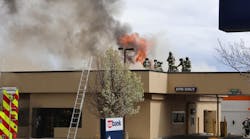A prominent publication has stirred up concern within the fire service and the general public by alleging a lack of willingness in the fire/rescue community to respond to victims of hybrid vehicle crashes.
The September issue of Car and Driver Magazine features a column by automotive writer Brock Yates, which states that "...a number of fire and EMS crews have announced that they will refuse to rescue victims trapped in such vehicles, openly fearing electrocution or fatal acid burns."
Neither Car and Driver Magazine nor Brock Yates responded to Firehouse.com's request to identify which fire departments made these alleged announcements, and fire service leaders questioned the veracity of the statement.
"I don't know why anyone would question the willingness of the fire service to handle any sort of emergency, and I don't believe, unless you can prove otherwise, there is any credible evidence to suggest that is actually happening," said International Association of Fire Fighters spokesman Jeff Zack.
"How is this different than responding to downed power lines or a chemical fire of some sort? This just doesn't appear credible on its face or in its substance," he said. "Firefighters have never shrunk in the face of adversity and I don't think they're doing it in this case."
The National Volunteer Fire Council agreed. "We're quite aware of the concern regarding hybrid vehicles, but I have not heard of any department saying, 'We're going to stop rescuing people in these vehicles,'" said spokesman Craig Sharman.
However, when asked about the fire/rescue service's current state of preparedness to respond to hybrid vehicles, no one can give a definitive answer because there is no formal distribution of hybrid vehicle response information. The burden is on individual agencies to seek out the information, but experts say it is common knowledge in the fire/rescue community that hybrid vehicle manufacturers provide emergency response guide books for free online and through local dealerships.
Although there are still relatively few hybrid vehicles on the road, they do get into accidents and rescue workers do need to be prepared. An Internet search revealed at least three newsworthy crashes of hybrid cars during the month of August, in Maryland, California and Florida.
So far these accidents have not caused notable problems for rescue workers. According to the National Highway Traffic Safety Administration, "To date, the NHTSA has not had any reports of difficulties involving extrication or emergency techniques with these vehicles," said spokeswoman Elly Martin.
Ron Moore, author of the University of Extrication series featured in Firehouse magazine and moderator of the University of Extrication interactive web site on Firehouse.com, says that with training, no fire department would make the statement alleged in Car and Driver.
To refuse to respond to hybrid vehicle crashes would be unnecessary, as well as an issue of liability and discrimination, he said. "I have never heard of a department that would be so foolish as to make that statement," Moore said.
When hybrids initially came out, there was a lot of hype among rescuers about the possibility of electrocution if the car went into a ditch of water, or of electrocution caused by cutting the wrong wire, he said.
"All of those have turned out to be essentially urban legends because of the engineering of the vehicles," Moore said. "That isn't going to happen."
The reality, he said, is that hybrid vehicles pose manageable challenges, and educated rescue workers can manage a hybrid vehicle crash as safely as any other crash.
The first challenge, he said, is to even recognize that a vehicle is a hybrid because they have minimal exterior markings. A Honda Accord and a Honda Accord Hybrid look the same, Moore said, except that, "On the back of the Accord Hybrid -- on the trunk -- is a little extra word, that says 'Hybrid.'"
Next, Moore said, rescue workers need to disable the vehicle's 12-volt battery, similar to those found in a conventional vehicle. "At a normal crash we would raise the hood and cut or disconnect the 12-volt battery cables. It's a little bit more challenging on a hybrid."
One of the problems is that a hybrid can turn off its gasoline engine and "go to sleep," to save fuel when the car stops. "Now, if you are sitting at an intersection and are crashed into, when a firefighter or paramedic or police officer gets to your car, it will be totally silent," Moore said. "They could go around to the front to raise the hood, but it could be in sleep mode and drive forward on electricity, not using gas at all."
The hybrid Ford Escape can go 25 mph on electricity alone, Moore noted, and could run over rescuers while they're standing in front of it. "It would be like being run over by a big electric golf cart," he said.
To prevent this, rescue workers need to block the wheels, get inside the vehicle, put it in "park" or set the emergency brake, and turn the ignition off. Then the vehicle is truly shut down, Moore said, and rescuers can work to shut down the 12-volt electrical system.
The 12-volt battery may be located under the hood or in the trunk, but rescuers need to find it and cut the power to insure that the high voltage power is isolated to the high voltage battery.
Once this is done, "Really at that point you're dealing with a conventional vehicle except that there is a high voltage battery on the vehicle," Moore said. Emergency scene operations will not require working directly on the high-voltage battery pack, and it should not pose any further threat. "You could be electrocuted at an accident if for some reason you decided to physically tear into the high voltage battery itself, which is inconceivable," he said.
Moore also noted the safety precautions engineered into the vehicles. For example, if the air bags deploy, or if water reaches the level of the high voltage battery, the high voltage power shuts down.
In addition, all manufacturers make the high voltage wiring and connections orange. Also, if the battery is in the trunk, the wiring runs underneath the car, not through it. "What they've done on purpose, is they've avoided putting wiring in any of the areas that we typically cut during an extrication," Moore said.
"Hybrid vehicles are hazardous and they can kill us, but with a couple of simple steps, we can quickly take this new technology and manage it and make the crash scene into a routine scenario," he said.
Moore stressed that all manufacturers of hybrid vehicles sold in the U.S. offer emergency response guide books at their web sites. "They are totally free, downloadable, and they are a great training document that would allow any responder group - ambulance, police or fire department - to begin to become aware of how to deal with hybrid vehicles."
Related:
- University of Extrication
- Toyota/Lexus Alternate Fueled Vehicles Emergency Response Guides
- Honda Emergency Response Guide for Hybrid Vehicles
- Ford Escape Hybrid Emergency Response Guide
- IAFF - Hybrid Vehicles and Emergency Response
- NHTSA - Approaching Alternative-Fueled Vehicle Crashes
- NHTSA - Disconnect Vehicle Batteries Safely





